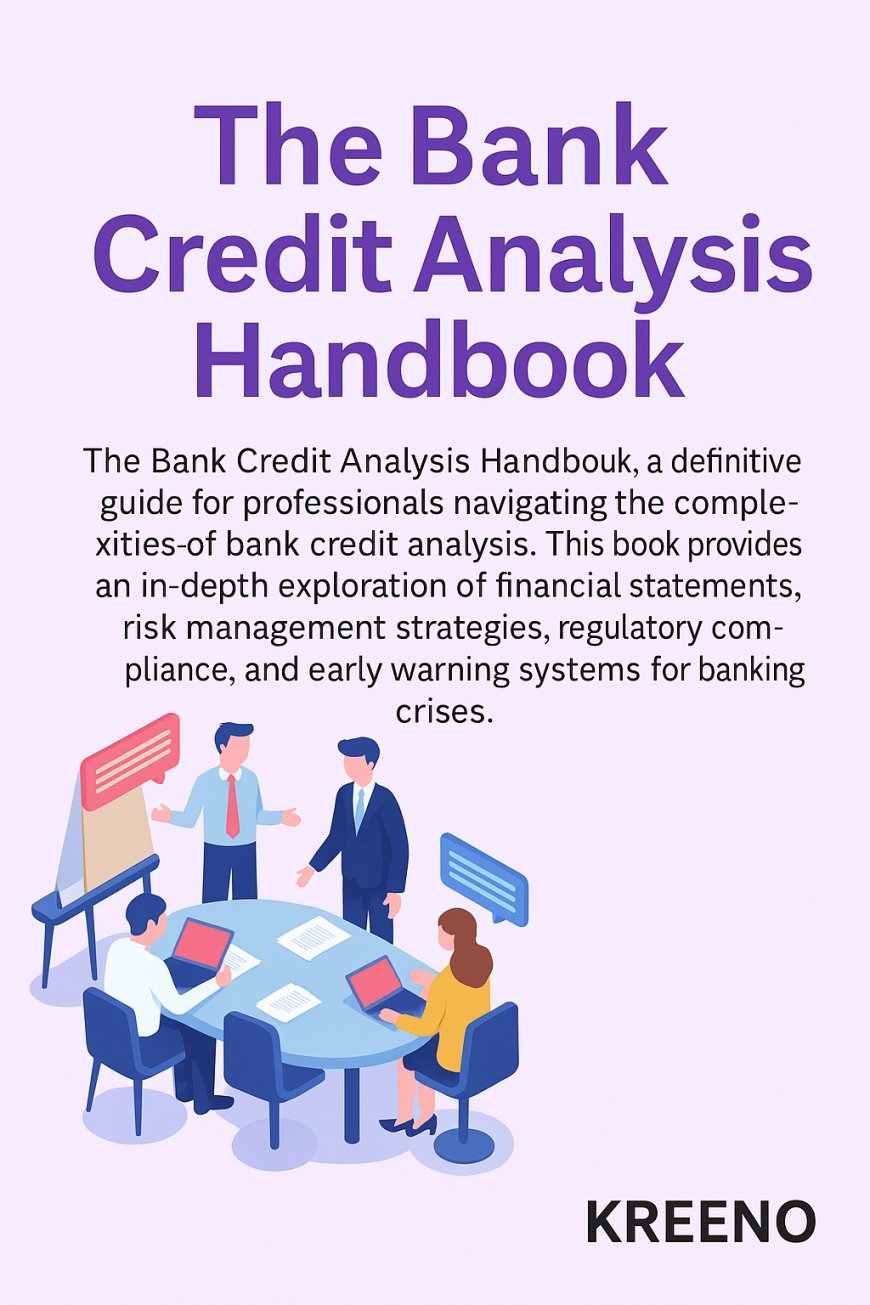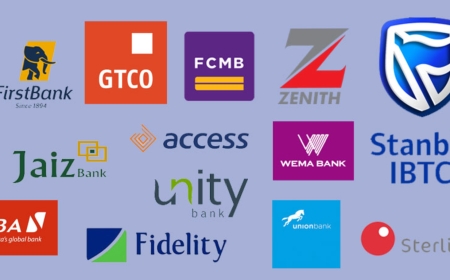Mastering Bank Credit Analysis: Essential Insights for Analysts, Bankers, and Investors
Dive into The Bank Credit Analysis Handbook , a definitive guide for professionals navigating the complexities of bank credit analysis. This book provides an in-depth exploration of financial statements, risk management strategies, regulatory compliance, and early warning systems for banking crises. Book reviewed by Dr. Ohio O. Ojeagbase FICA, this resource equips analysts, bankers, and investors with the tools to evaluate the creditworthiness of financial institutions effectively. Whether you're assessing asset quality, liquidity, or solvency risks, this handbook offers actionable insights and practical methodologies to enhance decision-making in today's dynamic financial landscape.

The Evolution and Importance of Bank Credit Analysis in Modern Finance
In the intricate world of finance, where the stability and growth of economies heavily rely on the robustness of banking institutions, the role of bank credit analysis emerges as a cornerstone. As articulated in The Bank Credit Analysis Handbook: A Guide for Analysts, Bankers and Investors with primary author as Jonathan Golin and co-authored by Philippe Delhaise and is being reviewed by Dr. Ohio O. Ojeagbase FICA, this discipline is not merely about assessing financial statements but delving deep into the operational efficiencies, risk management strategies, and overall health of banking entities. The handbook provides an exhaustive exploration of these aspects, setting a benchmark for analytical rigor and strategic insight.
Bank credit analysis has evolved significantly over the decades, transforming from rudimentary assessments focused primarily on assets and liabilities to sophisticated evaluations that encompass a myriad of factors including market risks, regulatory compliance, and technological advancements. This evolution reflects the changing landscape of global finance, where banks are increasingly seen not just as repositories of wealth but as dynamic engines of economic development. This work captures this transformation meticulously, offering readers a panoramic view of how modern banking practices have shaped and been shaped by the demands of contemporary markets.
Understanding the importance of bank credit analysis is crucial for anyone involved in the financial sector. It equips analysts, bankers, lenders, and investors with the tools necessary to make informed decisions, mitigate risks, and capitalize on opportunities. By dissecting complex financial data and interpreting them within broader economic contexts, practitioners can gauge the resilience of banks against potential crises and their capacity to sustain growth. The handbook underscores this necessity by providing case studies and real-world examples that illustrate the practical applications of theoretical concepts.
Moreover, the insights offered in the handbook extend beyond mere technical guidance. They foster a deeper appreciation of the symbiotic relationship between banks and the economies they serve. In an era marked by rapid technological advancements and shifting regulatory landscapes, the ability to conduct thorough credit analyses is indispensable. It ensures that banks and lenders remain solvent and capable of fulfilling their roles as custodians of public trust and facilitators of economic activity.
Thus, as we delve into the detailed discussions presented in The Bank Credit Analysis Handbook, it becomes evident that this work is not just a manual for credit analysis but a comprehensive guide to understanding the vital functions of banks in today’s interconnected world. The handbook stands as a testament to the critical role of analytical precision and strategic foresight in maintaining the stability and prosperity of global financial systems.
Understanding Earnings Sources in Banking: Interest Income vs. Non-Interest Revenue
In the realm of banking, earnings are primarily bifurcated into two distinct streams: interest income derived from various assets and non-interest revenues encompassing fees, commissions, and trading gains. This division not only delineates the revenue generation mechanisms inherent to banking operations but also highlights the structural differences in the income statements of banks compared to non-financial firms. According to The Bank Credit Analysis Handbook, understanding these sources is pivotal for a comprehensive evaluation of a bank’s financial health and profitability.
Interest income, the traditional backbone of banking profits, arises from loans, mortgages, and other credit instruments extended to customers. These assets generate returns through predetermined interest rates, forming a predictable yet susceptible-to-market-fluctuations income stream. On the other hand, non-interest income, which includes service charges, roll over fees, transaction fees, and gains from securities trading, offers a more volatile yet potentially lucrative avenue for revenue enhancement. The handbook emphasizes that whilst non-interest income can significantly boost profitability, it also introduces increased exposure to market risks, necessitating robust risk management frameworks.
The structural impact of these diverse earnings sources on a bank’s income statement is profound. Unlike non-financial companies that rely predominantly on sales or service provision for revenue, banks exhibit a dual reliance on both asset-based and service-based income. This duality requires a nuanced approach to financial reporting, where the volatility and predictability of each income type must be carefully balanced and communicated. This handbook provides illustrative scenarios that underscore the complexity of managing these income streams efficiently to maintain financial stability and achieve sustainable growth.
Furthermore, the interplay between interest and non-interest incomes affects a bank’s overall risk profile. For instance, heavy reliance on trading activities for revenue might expose a bank to significant market fluctuations, thereby affecting its capital adequacy and liquidity positions. Conversely, a well-diversified income portfolio can cushion against market volatilities, enhancing resilience during economic downturns. The handbook adeptly navigates these intricacies, offering strategic insights into optimizing income structures whilst mitigating associated risks.
In conclusion, the differentiation between interest and non-interest earnings is not merely an academic exercise but a fundamental aspect of bank credit analysis. By dissecting these sources, analysts and stakeholders gain a clearer picture of a bank’s operational dynamics and risk exposures, enabling more informed decision-making processes. As underscored by author Jonathan Golin and co-author Philippe Delhaise, mastering these elements is essential for anyone involved in the financial assessment and strategic planning within the banking sector.
Evaluating Bank Performance Through Key Financial Ratios
In the meticulous task of evaluating a bank's performance, certain financial ratios emerge as pivotal indicators, each offering unique insights into different facets of a bank's operational efficiency and financial health. Amongst these, the cost-to-income ratio and the return on equity stand out as particularly telling metrics, as elucidated in The Bank Credit Analysis Handbook.
The cost-to-income ratio serves as a direct measure of a bank's operational efficiency. It calculates the percentage of operating expenses relative to its operating income, effectively showcasing how much it costs a bank to generate each unit of income. A lower cost-to-income ratio typically indicates a more efficient operation, suggesting that a bank is adept at controlling its costs while maximizing its income generation. For instance, if a bank exhibits a cost-to-income ratio of 50%, it means that for every dollar earned in income, fifty cents are spent on operational costs. This ratio is crucial for analysts and investors who seek to understand whether a bank is maintaining sustainable operational practices without compromising on profitability.
On the other end of the spectrum, the return on equity (ROE) measures a bank's profitability concerning its shareholders' equity. ROE is calculated by dividing net income by shareholders' equity, providing a clear picture of how effectively a bank uses its equity base to generate profits. A high ROE is generally favorable, indicating that a bank is proficient at utilizing shareholder investments to produce substantial returns. However, an excessively high ROE might signal excessive risk-taking, which could jeopardize long-term stability. Therefore, while a robust ROE is desirable, it must be balanced against prudent risk management practices to ensure enduring financial health.
The handbook provides several scenarios illustrating how variations in these ratios can reflect underlying shifts in a bank’s strategic focus or operational challenges. For example, a sudden spike in the cost-to-income ratio might suggest inefficiencies creeping into the system, perhaps due to increased regulatory compliance costs or investment in new technologies that have yet to yield returns. Conversely, a declining ROE could indicate either a reduction in profitability or an increase in equity that hasn’t been matched by proportional income growth, possibly due to fresh capital injections.
By leveraging these ratios, stakeholders can glean actionable insights into a bank’s current positioning and future prospects. The cost-to-income ratio and ROE are not just numbers but narratives that unfold the story of a bank’s journey through the financial landscape. They provide a lens through which the complexities of bank operations can be simplified into understandable and actionable data points. As such, these metrics are indispensable tools in the arsenal of any analyst or investor looking to navigate the intricate world of banking finance with confidence and acumen.

Early Warning Systems in Banking Crisis Prediction
In the quest to preemptively identify and mitigate banking crises, early warning systems (EWS) have emerged as pivotal tools, encapsulated thoroughly in The Bank Credit Analysis Handbook. These systems, designed to flag potential financial instability before it manifests into a full-blown crisis, utilize a range of indicators and methodologies, each contributing uniquely to the predictive accuracy and reliability of the predictions.
One of the primary methodologies involves the use of macroeconomic indicators such as GDP growth rates, inflation levels, and unemployment figures. These indicators provide a broad overview of economic health and are often the first line of detection for systemic issues. For instance, a sudden drop in GDP growth coupled with rising unemployment could signal impending economic distress, prompting further investigation into the banking sector's stability.
Additionally, microeconomic indicators play a crucial role in these systems. These include specific banking metrics such as the loan-to-deposit ratio, non-performing loan ratios, and capital adequacy ratios. Each of these indicators offers a window into the operational soundness and risk exposure of individual banks. For example, a consistently high loan-to-deposit ratio might indicate over-leveraging, increasing the vulnerability of a bank to liquidity crises.
Statistical models form another cornerstone of effective EWS. Techniques such as logistic regression, probit models, and machine learning algorithms are employed to analyze historical data and identify patterns indicative of past crises. These models help in quantifying the probability of crisis occurrence, allowing regulators and analysts to prioritize interventions based on risk severity. The handbook details how advancements in computational power and data analytics have enhanced the precision of these models, making them indispensable in modern banking surveillance.
However, despite their sophistication, the effectiveness of early warning systems is contingent upon the quality and timeliness of data utilized. Inaccurate or delayed data can lead to false positives or missed warnings, undermining the reliability of the system. Moreover, the dynamic nature of financial markets necessitates continuous updates and recalibrations of these systems to maintain their predictive edge.
Through the lens of The Bank Credit Analysis Handbook, it is evident that early warning systems are not infallible but represent a critical component in the proactive management of banking crises. By integrating a blend of macroeconomic, microeconomic, and statistical methodologies, these systems empower stakeholders to anticipate and mitigate risks, safeguarding the financial ecosystem against potential upheavals. Jonathan Golin and Philippe Delhaise insights underscore the imperative for ongoing research and adaptation in EWS methodologies to keep pace with evolving financial landscapes and emerging risks.
- ACP Dr Emmanuel Jackson Retires From Police
- Dr Victor O. Etuokwu: Celebrating A Legacy Excellence, Leadership, and Impact
- Celebrating Excellence: A tribute To Mrs. Olaghere
- Celebrating The Birthday Of The King Of Debt Recovery In Nigeria 2024
- Legacy Etched In Honor: Celebrating The Exceptional Career Of CP Godwin Ayotunde Omodeinde
Risk Management and Basel Accords: Foundations of Financial Stability
In the intricate tapestry of global banking, the implementation of robust risk management strategies and adherence to the Basel Accords stand as pillars ensuring financial stability and resilience against crises. As detailed in The Bank Credit Analysis Handbook, these frameworks not only shape the operational ethos of banks but also define the parameters within which financial institutions operate globally.
Risk management in banking encompasses a broad spectrum of practices aimed at identifying, assessing, and prioritizing risks followed by coordinated application of resources to minimize, monitor, and control the probability or impact of unfortunate events. Central to this process is the concept of Value-at-Risk (VaR), a statistical technique used to measure and quantify the level of financial risk within a firm or investment portfolio over a specific time frame. VaR provides a probabilistic estimate of the worst expected loss under normal market conditions, thus serving as a critical tool for risk managers. However, as highlighted in the handbook, while VaR offers valuable insights, it should be complemented by qualitative judgment and experience-based assessment to fully capture the complexities of financial risks.
The Basel Accords, initiated by the Basel Committee on Banking Supervision, represent a set of recommendations on banking regulations concerning capital risk, market risk, and operational risk. The accords aim to ensure that financial institutions hold enough capital to meet obligations and absorb unexpected losses. Basel I, introduced in 1988, primarily focused on credit risk, prescribing a minimum capital requirement of 8% of risk-weighted assets. Basel II expanded on this foundation by incorporating operational and market risks alongside refined credit risk measurements, promoting a more risk-sensitive framework. The most recent iteration, Basel III, introduced in response to the 2008 financial crisis, further strengthens bank capital requirements, introduces liquidity standards, and enhances risk management practices.
This handbook delves into the nuances of these accords, illustrating how they collectively contribute to a safer banking environment. By mandating stringent capital adequacy ratios and promoting transparency in risk exposure, the Basel Accords equip banks with the tools necessary to withstand economic shocks. Furthermore, the emphasis on liquidity coverage ratios and net stable funding ratios under Basel III ensures that banks maintain sufficient high-quality liquid assets to survive acute liquidity stress scenarios lasting for 30 days, thereby preventing liquidity crises.
However, the implementation of these rigorous standards poses challenges, particularly for smaller banks with limited resources. The handbook discusses various strategies employed by banks to comply with Basel requirements while maintaining operational efficiency and profitability. These include adopting advanced risk modeling techniques, enhancing internal audit processes, and investing in technology to improve data management and reporting capabilities.
In conclusion, the integration of comprehensive risk management strategies and adherence to the Basel Accords are indispensable for fostering a resilient banking sector. As underscored by Jonathan Golin and Philippe Delhaisel, these frameworks not only safeguard the interests of depositors and investors but also uphold the integrity of the global financial system. By continually refining these practices, banks can navigate the complexities of modern finance with greater confidence and stability, ensuring long-term sustainability and trust in the financial markets.
Resolving Banking Crises: Comparative Approaches Across Nations
In addressing the multifaceted challenges posed by banking crises, nations around the globe have adopted varied resolution mechanisms, each tailored to their unique economic environments and policy objectives. The Bank Credit Analysis Handbook, author Jonathan Golin and co-author Philippe Delhaise, provides a comparative analysis of these approaches, highlighting the effectiveness and adaptability of different strategies across diverse contexts.
The United States, through its Resolution Trust Corporation (RTC), exemplifies a rapid liquidation or fire-sale approach. Established in the aftermath of the savings and loan crisis of the 1980s, the RTC was tasked with liquidating assets from failed savings and loan associations swiftly to recover taxpayer funds. This method, characterized by its urgency and focus on immediate recovery, proved effective in stabilizing the U.S. financial sector by quickly removing toxic assets from the banking system. However, critics argue that the haste often led to undervaluation of assets, potentially resulting in significant financial losses.
Contrastingly, Sweden’s Securum represents a rehabilitation and optimization of returns/middle approach. Following the Swedish banking crisis of the early 1990s, Securum was established to manage and rehabilitate distressed assets rather than liquidate them immediately. This strategy allowed for the restructuring of viable businesses and the gradual sale of assets at more optimal prices, thus preserving value and employment. The success of this approach lies in its balance between immediate action and long-term recovery, although it requires substantial initial investment and a strong regulatory framework to prevent misuse of funds.
Japan’s Credit Corporation for Small Business (CCPC) and Mexico’s Fund for Banking Savings Protection (FOBAPROA) illustrate the long-term warehousing/gradualist approach. Both entities were created to handle non-performing loans over an extended period, allowing the market to stabilize naturally. This method reduces the pressure on banks to sell assets at distressed prices but demands patience and sustained government support. The prolonged timeline can be a double-edged sword, as it may delay economic recovery and increase fiscal burdens.
Thailand’s Financial Restructuring Authority (FRA) and Malaysia’s Danaharta offer additional insights into middle-ground strategies that combine elements of both rapid liquidation and gradual rehabilitation. These organizations were designed to manage bad debts through a mix of asset sales and restructuring efforts, adapting their strategies based on market conditions and asset types. Such flexibility allows for a more tailored response to financial crises but requires sophisticated management and a deep understanding of market dynamics.
Korea’s Korea Asset Management Corporation (KAMCO) further enriches this comparative study by demonstrating a hybrid model that incorporates aggressive initial asset disposals followed by structured rehabilitation programs. KAMCO’s approach underscores the importance of adaptability in crisis resolution, as it shifted strategies based on the evolving economic landscape post-Asian financial crisis.
Through these varied case studies, The Bank Credit Analysis Handbook underscores the complexity and context-dependency of banking crisis resolution. Jonathan Golin and Philippe Delhaisel insights emphasize that no single approach universally fits all scenarios; instead, successful resolution often hinges on a combination of timely intervention, strategic asset management, and robust regulatory oversight. By examining these international paradigms, policymakers and financial analysts can better appreciate the nuances of crisis management and develop more resilient financial systems capable of withstanding future disruptions.

The Dynamics of Liquidity Management in Banking Operations
Liquidity management stands as a cornerstone of banking operations, pivotal in ensuring the seamless functioning and stability of financial institutions. As elaborated in The Bank Credit Analysis Handbook, under the insightful editorial direction of Jonathan Golin and Philippe Delhaisel, the intricacies of liquidity—its definition, measurement, and management—are crucial for both sustaining daily operations and preparing for unforeseen financial exigencies.
At its core, liquidity refers to the ability of a bank to fund its assets and meet its obligations as they become due. This capability is underpinned by the possession of liquid or quasi-liquid assets, which include cash, coin, currency, and assets readily convertible into cash. The handbook emphasizes that effective liquidity management not only involves maintaining adequate reserves but also strategically aligning these reserves with anticipated cash flows and obligations. This alignment is critical, as mismatches between asset maturities and liability obligations can precipitate liquidity crises, severely impacting a bank’s operational viability.
To measure liquidity, banks employ a variety of metrics and analytical tools. Commonly used indicators include the Liquidity Coverage Ratio (LCR) and the Net Stable Funding Ratio (NSFR). The LCR requires banks to hold an amount of high-quality liquid assets sufficient to survive a 30-day liquidity stress scenario, thereby ensuring short-term resilience. Conversely, the NSFR focuses on longer-term stability by requiring banks to maintain a stable funding profile in relation to the composition of their assets and off-balance sheet activities. These metrics, though standardized, require careful calibration to reflect the specific risk profiles and operational needs of individual banks.
Managing liquidity effectively demands a proactive approach, integrating both quantitative assessments and qualitative judgments. Banks must continuously monitor their liquidity positions, adjusting their asset-liability configurations in response to changing market conditions and internal business dynamics. This dynamic process involves not only the regular review of cash flow forecasts but also the strategic deployment of liquidity buffers to absorb shocks. Moreover, the handbook highlights the importance of stress testing as a tool for simulating adverse scenarios and assessing the robustness of liquidity management strategies.
Jonathan Golin and Philippe Delhaisel insights further illuminate the challenges inherent in liquidity management, particularly in an era marked by rapid technological advancements and fluctuating regulatory landscapes. The increasing digitization of banking services and the emergence of fintech innovations have introduced new dimensions of liquidity risk, necessitating adaptive management practices. Additionally, the global interconnectedness of financial markets amplifies the potential for contagion effects, underscoring the need for robust cross-border liquidity arrangements and cooperative regulatory frameworks.
In conclusion, the management of liquidity is not merely a technical exercise but a strategic imperative that influences every facet of banking operations. By adhering to the principles and practices outlined in The Bank Credit Analysis Handbook, banks can enhance their resilience against liquidity shocks, thereby supporting the broader objective of financial stability. As underscored by Jonathan Golin and Philippe Delhaisel, mastering liquidity management is essential for navigating the complexities of modern banking, ensuring that financial institutions remain agile, responsive, and steadfast in their commitment to economic prosperity.
Reflections on Governance, Innovation, and Future Directions in Banking
As we culminate our exploration of The Bank Credit Analysis Handbook, authored and co-authored by the esteemed Jonathan Golin and Philippe Delhaisel respectively, it is imperative to reflect on the overarching themes of governance, innovation, and the future trajectory of the banking sector. These elements not only encapsulate the essence of modern banking but also chart the course for its evolution amidst a rapidly changing global financial landscape.
Governance in banking extends beyond the traditional realms of compliance and regulation; it embodies the ethical stewardship and strategic foresight that guide financial institutions. As discussed extensively in the handbook, effective governance frameworks are foundational to maintaining public trust and ensuring the equitable distribution of financial resources. They necessitate a harmonious blend of accountability, transparency, and inclusivity, fostering environments where innovation can thrive responsibly. Jonathan Golin and Philippe Delhaisel insights underscore the significance of embedding robust governance structures that can adapt to emerging challenges, thereby reinforcing the resilience of banking systems worldwide.
Innovation, on the other hand, represents the lifeblood of banking evolution. From the advent of digital currencies to the integration of artificial intelligence in risk assessment and customer service, technological advancements continue to redefine the boundaries of what is possible in banking. The handbook elucidates how these innovations not only enhance operational efficiencies but also democratize access to financial services, bridging gaps in underserved markets. However, as Jonathan Golin and Philippe Delhaisel astutely notes, the pursuit of innovation must be tempered with caution, ensuring that technological integrations do not compromise security or ethical standards.
Looking towards the future, the banking sector stands at a pivotal juncture. The convergence of heightened regulatory scrutiny, technological disruption, and shifting consumer expectations calls for a reimagining of traditional banking paradigms. The handbook posits that the banks of tomorrow will be characterized by their agility and adaptability, capable of navigating the complexities of a digital-first economy while upholding the tenets of sound financial management. This vision for the future is not merely aspirational but a call to action for stakeholders across the banking ecosystem to embrace change proactively and constructively.
Jonathan Golin and Philippe Delhaisel compilation serves as a beacon for those navigating the intricate pathways of modern banking. It reinforces the notion that governance and innovation are not mutually exclusive but complementary forces driving the sector forward. As we look ahead, the lessons distilled from this comprehensive handbook will undoubtedly guide policymakers, practitioners, and scholars in sculpting a banking landscape that is not only resilient and innovative but also equitable and sustainable.
In essence, The Bank Credit Analysis Handbook transcends its role as a mere reference material. It embodies a manifesto for the future of banking—a future where governance and innovation coalesce to create financial systems that are robust, inclusive, and forward-thinking. Under Jonathan Golin and Philippe Delhaisel editorial leadership, this handbook not only informs but inspires, urging us to envision and enact a banking paradigm that truly serves the global community.
Kindly share this story:
Contact: report@probitasreport.com
Stay informed and ahead of the curve! Follow The ProbitasReport Online News Report on WhatsApp for real-time updates, breaking news, and exclusive content especially when it comes to integrity in business and financial fraud reporting. Don't miss any headline – and follow ProbitasReport on social media platforms @probitasreport
[©2025 ProbitasReport - All Rights Reserved. Reproduction or redistribution requires explicit permission.]
What's Your Reaction?


































































































